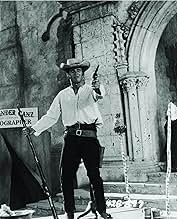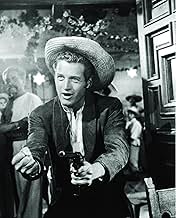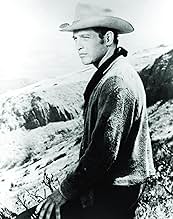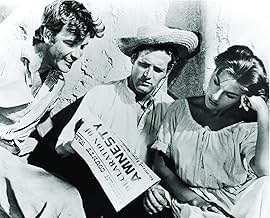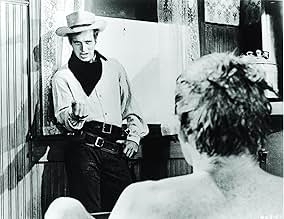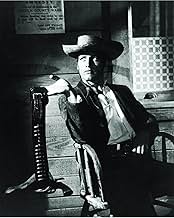NOTE IMDb
6,4/10
4,9 k
MA NOTE
Ajouter une intrigue dans votre langueAfter his employer is murdered by rival cattlemen, a troubled and uneducated young cowboy vows revenge on the murderers.After his employer is murdered by rival cattlemen, a troubled and uneducated young cowboy vows revenge on the murderers.After his employer is murdered by rival cattlemen, a troubled and uneducated young cowboy vows revenge on the murderers.
- Réalisation
- Scénario
- Casting principal
- Récompenses
- 1 victoire au total
Robert Anderson
- Hill
- (as Bob Anderson)
Josephine Parra
- Bride
- (as Jo Summers)
Avis à la une
Billy The Kid has been played on screen by many actors, of whom Paul Newman may have been the most justly famous. So why is his Billy such a drip?
Newman was 33 years old and had managed to make the most of his second chance at screen fame with a solid turn in "Somebody Up There Likes Me," playing a rebellious young boxer. As Billy, though, Newman seems lost as a similar character of sudden impulse. "All I know is how I feel," he says, and that's true whether he's brooding Brando-like over the death of a rancher he just met or dancing up a storm three minutes later. For every scene he plays with his trademark cool, there must be four or five he exaggerates to strange effect.
It's a strange movie with or without him. Celebrated by some as a psychological western, it presents Billy as neither evil nor a sociopath, but rather as tied up by an understandable if extreme need for revenge. There was this guy, you see, who gave Billy a job and then got shot by some corrupt peace officers, and he promised to teach poor Billy to read.
Never mind that Billy doesn't know this guy when the movie starts and he's already dead ten minutes in. Nor that Billy's two partners-in-crime, Tom (James Best) and Charley (James Congdon), have no clear reason for siding with their hot-tempered friend. "The Left-Handed Gun" is a film in a hurry, mainly to give Newman as much opportunity to emote as possible. Boy, does Newman emote!
Compositionally, "The Left-Handed Gun" does some interesting things. We see Billy's first gunfight through a steamed-up window taking place while Billy simultaneously maps it out, a terrific effect. Director Arthur Penn and cinematographer J. Peverell Marley (not a harmonious team, as Penn reveals in a DVD commentary) continually find unique details to capture the eye, like one man's face pressed against a window glass after taking a fatal bullet. In his movie blog "Nothing Is Written," Groggy Dundee points out just how much of Penn's big escape scene made it into the later Sam Peckinpah movie "Pat Garrett And Billy The Kid," to the point of identical blocking and camera angles.
This is a better film that that one, which is overlong and cattywampus. Penn makes a point in his DVD commentary about the film being taken away from him in the editing room, and there's much sloppiness in evidence in the final cut, like Tom taking the same bullet in two consecutive scenes. But Penn must take the blame for a cast that overplays way too much, as if Newman's Method acting style was the swine flu. Best either whacks his hat or giggles constantly, while John Dehner as Pat Garrett has an atrocious scene where he whines at Billy for shooting a guy during his wedding reception.
"This wall, this street, this town, I married all of it," Dehner screams. I shudder to imagine the honeymoon.
Best's future "Dukes Of Hazzard" castmate Denver Pyle sticks out in a better way as the ornery Ollinger, while Hurd Hatfield coos over Billy as an overly florid Southern writer who wants to make his fortune writing up Billy's career. Considering this was based on a play by Gore Vidal, there may be a subtext there, though Hatfield works his few scenes more in the direction of a creepier Vincent Price. I liked him, even if I don't think he got across anything more than a hint of an idea about our exploitative celebrity culture.
That's the problem with "Left-Handed Gun," aiming too high and not getting what it shoots for. That and Newman, who shows some star power here but not much acting skill. Unlike Billy, he had time to get better.
Newman was 33 years old and had managed to make the most of his second chance at screen fame with a solid turn in "Somebody Up There Likes Me," playing a rebellious young boxer. As Billy, though, Newman seems lost as a similar character of sudden impulse. "All I know is how I feel," he says, and that's true whether he's brooding Brando-like over the death of a rancher he just met or dancing up a storm three minutes later. For every scene he plays with his trademark cool, there must be four or five he exaggerates to strange effect.
It's a strange movie with or without him. Celebrated by some as a psychological western, it presents Billy as neither evil nor a sociopath, but rather as tied up by an understandable if extreme need for revenge. There was this guy, you see, who gave Billy a job and then got shot by some corrupt peace officers, and he promised to teach poor Billy to read.
Never mind that Billy doesn't know this guy when the movie starts and he's already dead ten minutes in. Nor that Billy's two partners-in-crime, Tom (James Best) and Charley (James Congdon), have no clear reason for siding with their hot-tempered friend. "The Left-Handed Gun" is a film in a hurry, mainly to give Newman as much opportunity to emote as possible. Boy, does Newman emote!
Compositionally, "The Left-Handed Gun" does some interesting things. We see Billy's first gunfight through a steamed-up window taking place while Billy simultaneously maps it out, a terrific effect. Director Arthur Penn and cinematographer J. Peverell Marley (not a harmonious team, as Penn reveals in a DVD commentary) continually find unique details to capture the eye, like one man's face pressed against a window glass after taking a fatal bullet. In his movie blog "Nothing Is Written," Groggy Dundee points out just how much of Penn's big escape scene made it into the later Sam Peckinpah movie "Pat Garrett And Billy The Kid," to the point of identical blocking and camera angles.
This is a better film that that one, which is overlong and cattywampus. Penn makes a point in his DVD commentary about the film being taken away from him in the editing room, and there's much sloppiness in evidence in the final cut, like Tom taking the same bullet in two consecutive scenes. But Penn must take the blame for a cast that overplays way too much, as if Newman's Method acting style was the swine flu. Best either whacks his hat or giggles constantly, while John Dehner as Pat Garrett has an atrocious scene where he whines at Billy for shooting a guy during his wedding reception.
"This wall, this street, this town, I married all of it," Dehner screams. I shudder to imagine the honeymoon.
Best's future "Dukes Of Hazzard" castmate Denver Pyle sticks out in a better way as the ornery Ollinger, while Hurd Hatfield coos over Billy as an overly florid Southern writer who wants to make his fortune writing up Billy's career. Considering this was based on a play by Gore Vidal, there may be a subtext there, though Hatfield works his few scenes more in the direction of a creepier Vincent Price. I liked him, even if I don't think he got across anything more than a hint of an idea about our exploitative celebrity culture.
That's the problem with "Left-Handed Gun," aiming too high and not getting what it shoots for. That and Newman, who shows some star power here but not much acting skill. Unlike Billy, he had time to get better.
While wandering in a desert area with the saddle of his deceased horse on his back, the drifter William "Billy the Kid" Bonney (Paul Newman) stumbles with the cattle owner John "The Englishman" Tunstall (Colin Keith-Johnston) that asks him what he wants and William asks for a job. Tunstall hires him to help to bring his cattle to Lincoln to sell the herd to the army and William befriends him. However, the local Sheriff Brady (Robert Foulk) ambushes Tunstal with the rancher Morton (Robert Griffin), his Deputy Moon (Wally Brown) and Hill (Bob Anderson) and kill the cattleman to avoid the business and steal his herd. Billy the Kid promises revenge against the men and together with his friends Charlie Boudre (James Congdon) and Tom Folliard (James Best), he kills Brady and Morton. Billy hides at McSween's house that is burnt down to ashes and Billy is assumed dead by the population. He flees to Madeiro where he meets his friends Pat Garret (John Dehner), Saval (Martin Garralaga) and his daughter Celsa (Lita Milan) that loves Billy. Soon Governor Lew Wallace proclaims amnesty in the New Mexico Territory and Billy is free from any charge. However Moon and Hill are still alive and Billy still wants to revenge his friend.
"The Left Handed Gun" is a western that tells one version of the Billy the Kid story. Directed by Arthur Penn, the film is uneven, alternating good with silly moments. However, it is mandatory for fans of Paul Newman, Arthur Penn and westerns in general. My vote is seven.
Title (Brazil): "Um de Nós Morrerá" ("One of Us Will Die")
"The Left Handed Gun" is a western that tells one version of the Billy the Kid story. Directed by Arthur Penn, the film is uneven, alternating good with silly moments. However, it is mandatory for fans of Paul Newman, Arthur Penn and westerns in general. My vote is seven.
Title (Brazil): "Um de Nós Morrerá" ("One of Us Will Die")
The director of Bonnie & Clyde and Little Big Man is off to a promising start with The Left Handed Gun, his first film. The film stars a young Paul Newman as Billy the Kid. Billy, working as a ranch hand, swears revenge on the four men who ambushed and killed his boss.
That's about it for plot. Newman plays Billy well, portraying a man bent on his mission. One senses that he means well, but his short temper and dark past always get the best of him, even during his friend's, Pat Garrett (John Dehner in a nice performance), wedding.
Unfortunately, Newman suffers from a weak supporting cast and little character development. I found it hard to believe that Billy could develop such a strong bond with his boss in such a short time (although the movie doesn't exactly specify how long). With the possible exception of Garrett, the remaining players are there to fill up the screen.
In short, I wasn't disappointed with this film, but if you want to view a great Western about a man driven by revenge, definitely see John Wayne in The Searchers.
That's about it for plot. Newman plays Billy well, portraying a man bent on his mission. One senses that he means well, but his short temper and dark past always get the best of him, even during his friend's, Pat Garrett (John Dehner in a nice performance), wedding.
Unfortunately, Newman suffers from a weak supporting cast and little character development. I found it hard to believe that Billy could develop such a strong bond with his boss in such a short time (although the movie doesn't exactly specify how long). With the possible exception of Garrett, the remaining players are there to fill up the screen.
In short, I wasn't disappointed with this film, but if you want to view a great Western about a man driven by revenge, definitely see John Wayne in The Searchers.
This Film has Many Interesting Elements that may Attract Viewers. Director Arthur Penn's Debut, Early Paul Newman as an Iconic Western Outlaw, and a Different Artistic Approach to the Conventional Western.
However, the Movie is not the Easiest to Like. Penn's Flourishes are Welcome in a Genre so Ripe with Regularity, but Newman Overacts to the Point of Silliness and can Grate on the Nerves.
In Fact, just about Every Actor Emotes to Extreme, Except Perhaps John Dehner as Pat Garrett who Strikes a Concerned Lawman's Pose Quite Well Without Words. But even He is Guilty of One Scene that is Downright Atrocious (the this is my wedding, this is my town part).
Visually the Film has Many Interesting Shots and Flourishes, but Newman's Exaggeration of Body Language and Other Fanciful Displays that Misfire bring the Movie Down to just Above Average. There is Enough Curiosity here that is Worth a Watch, but Overall it is the Over Baked Acting that makes this a Disappointment.
However, the Movie is not the Easiest to Like. Penn's Flourishes are Welcome in a Genre so Ripe with Regularity, but Newman Overacts to the Point of Silliness and can Grate on the Nerves.
In Fact, just about Every Actor Emotes to Extreme, Except Perhaps John Dehner as Pat Garrett who Strikes a Concerned Lawman's Pose Quite Well Without Words. But even He is Guilty of One Scene that is Downright Atrocious (the this is my wedding, this is my town part).
Visually the Film has Many Interesting Shots and Flourishes, but Newman's Exaggeration of Body Language and Other Fanciful Displays that Misfire bring the Movie Down to just Above Average. There is Enough Curiosity here that is Worth a Watch, but Overall it is the Over Baked Acting that makes this a Disappointment.
I wonder what the mature Paul Newman thought of this early movie performance. Of course, 'mature' is a relative term since he's already 33 here, well beyond the 'kid' range. In my little book, it's the most mannered and misdirected acting of his long and distinguished career. It's almost like he's working at an excess of James Dean. That wouldn't be surprising since the screenplay's Billy comes across as more misunderstood youth than cold-blooded killer. I guess this is the first of director Penn's efforts at rehabilitating notorious American outlaws, leading up to the glossy Bonnie and Clyde (1967).
The movie itself is pretty good, the open range locations even looking like eastern New Mexico, while Penn uses them to good effect. But it's really James Best as the ill-fated henchman Tom who steals the film. His supporting role manages a certain poignancy that should have come from Billy, but doesn't. With the right breaks, I think Best could have carved a real niche in films. Speaking of supporting players, with the exception of the cartoonish Moultrie (Hatfield), they appear recruited from the many TV Westerns of the day, especially the familiar Denver Pyle and the classy John Dehner.
Penn establishes himself here as a moviemaker to watch with a number of nice touches— having Pyle squint into the sun just before the fateful moment, the lone boot left standing in the road, and others. I'm kind of sorry that the baby-faced Audie Murphy didn't get a shot at Billy's role. Visually, he's perfect. Plus, surprisingly for that boyish appearance, he could do a killer-stare to make you believe he killed 100 Germans during the war. Also, Murphy could have made that key facedown scene with Joe Bell (Pryor) as genuinely chilling as it should be. For whatever the charming Newman's considerable skills, being downright mean is not one of them. Anyway the movie remains an interesting entry on the road to 1960's-style rebellious movie-making.
The movie itself is pretty good, the open range locations even looking like eastern New Mexico, while Penn uses them to good effect. But it's really James Best as the ill-fated henchman Tom who steals the film. His supporting role manages a certain poignancy that should have come from Billy, but doesn't. With the right breaks, I think Best could have carved a real niche in films. Speaking of supporting players, with the exception of the cartoonish Moultrie (Hatfield), they appear recruited from the many TV Westerns of the day, especially the familiar Denver Pyle and the classy John Dehner.
Penn establishes himself here as a moviemaker to watch with a number of nice touches— having Pyle squint into the sun just before the fateful moment, the lone boot left standing in the road, and others. I'm kind of sorry that the baby-faced Audie Murphy didn't get a shot at Billy's role. Visually, he's perfect. Plus, surprisingly for that boyish appearance, he could do a killer-stare to make you believe he killed 100 Germans during the war. Also, Murphy could have made that key facedown scene with Joe Bell (Pryor) as genuinely chilling as it should be. For whatever the charming Newman's considerable skills, being downright mean is not one of them. Anyway the movie remains an interesting entry on the road to 1960's-style rebellious movie-making.
Le saviez-vous
- AnecdotesPaul Newman was widely felt to be miscast as Billy the Kid since at 33 he was considerably older than the character. Billy was supposed to be 18 at the beginning of the film.
- GaffesThe film is about western outlaw Billy the Kid, who was actually right-handed.
- ConnexionsFeatured in Legends of the West (1992)
Meilleurs choix
Connectez-vous pour évaluer et suivre la liste de favoris afin de recevoir des recommandations personnalisées
- How long is The Left Handed Gun?Alimenté par Alexa
Détails
- Date de sortie
- Pays d’origine
- Langues
- Aussi connu sous le nom de
- The Left Handed Gun
- Lieux de tournage
- Sociétés de production
- Voir plus de crédits d'entreprise sur IMDbPro
Box-office
- Budget
- 700 000 $US (estimé)
- Montant brut mondial
- 5 066 $US
- Durée1 heure 42 minutes
- Couleur
- Rapport de forme
- 1.85 : 1
Contribuer à cette page
Suggérer une modification ou ajouter du contenu manquant



